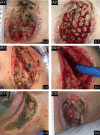Use of negative pressure wound therapy with instillation and a reticulated open cell foam dressing with through holes in the acute care setting
- PMID: 30784210
- PMCID: PMC7949336
- DOI: 10.1111/iwj.13097
Use of negative pressure wound therapy with instillation and a reticulated open cell foam dressing with through holes in the acute care setting
Abstract
Negative pressure wound therapy with instillation and dwell time (NPWTi-d) is an automated system used to deliver, dwell, and remove topical solutions from the wound bed. Recently, a reticulated open cell foam dressing with through holes (ROCF-CC) was developed, which assists with wound cleansing by removing thick exudate and infectious materials. We present our experience using NPWTi-d with ROCF-CC on complex wounds when complete surgical debridement was inappropriate because of medical instability, recurrent non-viable tissue, or palliative treatment plan. For all wounds, NPWTi-d with ROCF-CC was initiated by instilling normal saline, acetic acid, or hypochlorous acid with 2 to 10 minutes of dwell time, followed by 0.5 to 4 hours of negative pressure. Dressings were changed every 2 to 3 days. Fourteen patients with multiple comorbidities were treated for wound types including diabetic foot ulcers, necrotising fasciitis, dehisced wounds, and pressure injuries. Duration of NPWTi-d with ROCF-CC ranged from 1 to 15 days, and at dressing changes, wounds showed improved granulation tissue formation, less malodour, less surrounding erythema, and demarcation of healthy skin from devitalised tissue. Based on these patients, adjunctive use of NPWTi-d with ROCF-CC provided a practical option for improving tissue quality in wounds for patients in whom surgical debridement was not possible or desired.
Keywords: advanced practice nursing; negative pressure wound therapy; wound healing.
© 2019 Medicalhelplines.com Inc and John Wiley & Sons Ltd.
Conflict of interest statement
E.M. has a consulting agreement with KCI, an Acelity company, San Antonio, TX.
Figures




Similar articles
-
Use of Negative Pressure Wound Therapy With Instillation and a Novel Reticulated Open-cell Foam Dressing With Through Holes at a Level 2 Trauma Center.Wounds. 2019 Feb;31(2):55-58. Epub 2018 Nov 22. Wounds. 2019. PMID: 30485170
-
Use of Reticulated Open Cell Foam Dressings With Through Holes During Negative Pressure Wound Therapy With Instillation and Dwell Time: A Large Case Study.Wounds. 2020 Oct;32(10):279-282. Wounds. 2020. PMID: 33370246
-
Novel foam dressing using negative pressure wound therapy with instillation to remove thick exudate.Int Wound J. 2017 Oct;14(5):842-848. doi: 10.1111/iwj.12719. Epub 2017 Feb 28. Int Wound J. 2017. PMID: 28244217 Free PMC article. Review.
-
Early-stage Management of Complex Wounds Using Negative Pressure Wound Therapy With Instillation and a Dressing With Through Holes.Wounds. 2019 May;31(5):E33-E36. Wounds. 2019. PMID: 31184590
-
Use of a Novel Foam Dressing With Negative Pressure Wound Therapy and Instillation: Recommendations and Clinical Experience.Wounds. 2018 Mar;30(3 suppl):S1-S17. Wounds. 2018. PMID: 29723142
Cited by
-
Assessment between antiseptic and normal saline for negative pressure wound therapy with instillation and dwell time in diabetic foot infections.Sci Rep. 2024 May 19;14(1):11423. doi: 10.1038/s41598-024-58900-3. Sci Rep. 2024. PMID: 38763922 Free PMC article.
-
Negative Pressure Wound Therapy With Instillation and Dwell Time: Mechanisms of Action Literature Review.Eplasty. 2023 Aug 30;23:e54. eCollection 2023. Eplasty. 2023. PMID: 37743964 Free PMC article. Review.
-
Effectiveness of Negative Pressure Wound Therapy With Instillation and Dwell in Removing Nonviable Tissue, Promoting Granulation Tissue, and Reducing Surgical Debridements: A Systematic Literature Review.Wound Repair Regen. 2025 Jul-Aug;33(4):e70059. doi: 10.1111/wrr.70059. Wound Repair Regen. 2025. PMID: 40583835 Free PMC article. Review.
-
Research hotspots and trends in nursing for diabetic foot ulcers: A bibliometric analysis from 2013 to 2023.Heliyon. 2024 Aug 8;10(16):e36009. doi: 10.1016/j.heliyon.2024.e36009. eCollection 2024 Aug 30. Heliyon. 2024. PMID: 39224296 Free PMC article. Review.
-
[National expert consensus on the application of negative pressure wound therapy in the treatment of diabetic foot wounds (2021 version)].Zhonghua Shao Shang Za Zhi. 2021 Jun 10;37(6):508-518. doi: 10.3760/cma.j.cn.501120-20210107-00010. Online ahead of print. Zhonghua Shao Shang Za Zhi. 2021. PMID: 34139827 Free PMC article. Chinese.
References
-
- Milne J. Wound‐bed preparation: the importance of rapid and effective desloughing to promote healing. Br J Nurs. 2015;24:S52‐S58. - PubMed
-
- Percival SL, Suleman L. Slough and biofilm: removal of barriers to wound healing by desloughing. J Wound Care. 2015;24:498 500–503, 506. - PubMed
-
- Wolcott RD, Kennedy JP, Dowd SE. Regular debridement is the main tool for maintaining a healthy wound bed in most chronic wounds. J Wound Care. 2009;18:54‐56. - PubMed
-
- Panuncialman J, Falanga V. The science of wound bed preparation. Clin Plast Surg. 2007;34:621‐632. - PubMed
Publication types
MeSH terms
LinkOut - more resources
Full Text Sources
Medical

